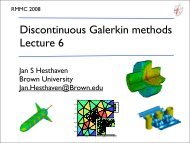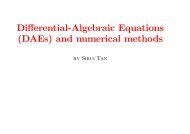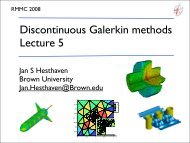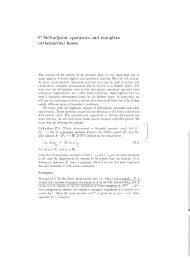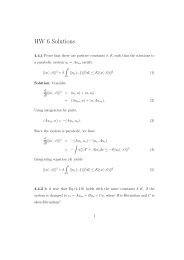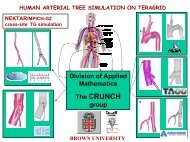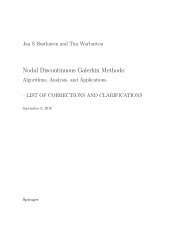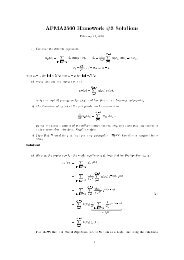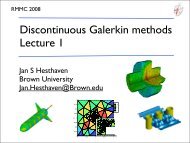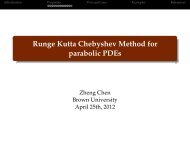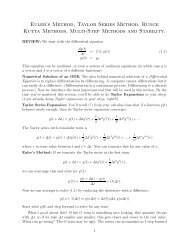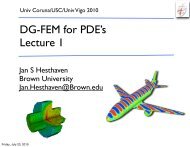MULTI-ELEMENT GENERALIZED POLYNOMIAL CHAOS FOR ...
MULTI-ELEMENT GENERALIZED POLYNOMIAL CHAOS FOR ...
MULTI-ELEMENT GENERALIZED POLYNOMIAL CHAOS FOR ...
Create successful ePaper yourself
Turn your PDF publications into a flip-book with our unique Google optimized e-Paper software.
902 XIAOLIANG WAN AND GEORGE EM KARNIADAKIS<br />
element method is generally used to solve the obtained deterministic PDE system, the<br />
above methods are called stochastic Galerkin finite element methods in [1], while the<br />
scheme in [14, 32] is classified as the p × h version and the scheme in [4] as the k × h<br />
version, where p denotes the polynomial order of PC, k the element size in the random<br />
space, and h the element size in the physical space. Both schemes use finite elements<br />
in the physical space. The p × h version relies on the spectral representation in the<br />
entire random space by PC, while the k × h version is based on the discretization<br />
of the random space using the same basis as the deterministic finite element method<br />
to approximate the random field locally. For simplicity, here we refer to the scheme<br />
in [14, 32] as a PC method of p-version and the scheme in [4] as a k-version. Both<br />
the concepts and the terminology introduced here share similarities with those of the<br />
spectral/hp element method for deterministic problems [17, 25].<br />
In this work, we present a multi-element generalized polynomial chaos (ME-gPC)<br />
method, which can deal with stochastic processes represented by random variables of<br />
arbitrary distributions and achieve kp-convergence in the random space. In the MEgPC<br />
method, we discretize the random space and use a spectral expansion locally<br />
to represent the desired random field. However, the PC basis is, in general, not<br />
orthogonal in a random element since the PDF is also discretized simultaneously. The<br />
only exception is the uniform distribution which has been considered so far in previous<br />
works [14, 4, 32, 28]. To overcome this difficulty, we reconstruct the orthogonal<br />
basis numerically in each random element. From the practical standpoint, it is more<br />
effective to employ a relatively low polynomial order (p =5top = 8) for the ME-gPC<br />
method. Thus, we can do this reconstruction on-the-fly with high accuracy for most<br />
continuous or discrete arbitrary probability measures.<br />
In certain nonlinear stochastic differential equations, random inputs can give rise<br />
to singularities as discussed in [18, 19] or the Kraichnan–Orszag problem [24], where<br />
the gPC method may converge very slowly or even fail to converge. By noting that<br />
singularities usually occur at a lower-dimensional manifold in the random space for<br />
such problems, we aim to “capture” the singular region by random elements related<br />
to a very small probability measure, and implement the gPC method in the regular<br />
region. Hence, the error in the singular region will be dominated by the size (kconvergence)<br />
of the random elements, while the error in the regular region decreases<br />
fast (p-convergence)—possibly exponentially fast. To reduce the total computational<br />
cost, we also present a criterion to implement the decomposition of random space<br />
adaptively.<br />
2. Multi-element generalized polynomial chaos (ME-gPC) method.<br />
2.1. Overview. The original PC was first proposed by Wiener [31]. It employs<br />
the Hermite polynomials in terms of Gaussian random variables as the trial basis<br />
to expand stochastic processes in the random space. According to the theorem by<br />
Cameron and Martin [3] such expansion converges for any second-order processes<br />
in the L2 sense. gPC was proposed in [33] and employs more types of orthogonal<br />
polynomials from the Askey family. It is a generalization of the original Wiener’s<br />
Hermite-chaos and can deal with non-Gaussian random inputs more efficiently.<br />
Let (Ω, F,P) be a probability space, where Ω is the sample space, F is the σalgebra<br />
of subsets of Ω, and P is a probability measure. Let<br />
(2.1)<br />
ξ =(ξ1,...,ξd) :(Ω, F) → (R d , B d )<br />
be an R d -valued continuous random variable, where d ∈ N and B d is the σ-algebra of<br />
Borel subsets of R d . A general second-order random process R(ω) ∈ L2(Ω, F,P) can



